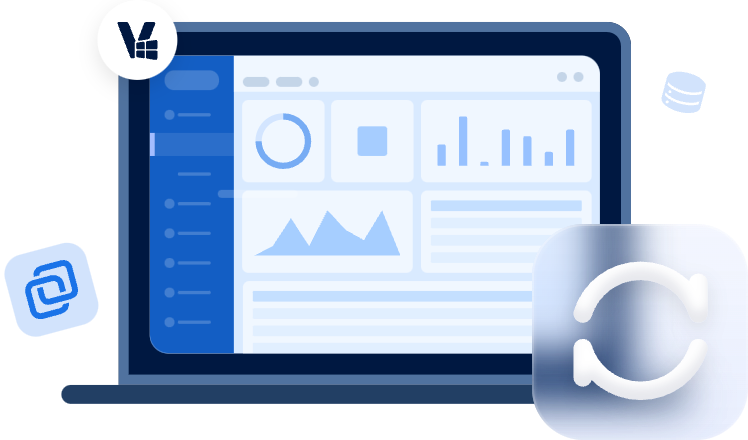VDI vs VHD vs VMDK: What’s the Differences & How to Choose
How to choose VDI, VHD, and VMDK, these three virtualized disk formats? How do you choose the right one for you? They can use in different situations, and both have advantages and disadvantages.
VDI vs VHD vs VMDK: Which will be better if I use VM on my SSD?
I want to know which type of hard disk file should I use if I am using VM on my SSD. I just care about the lifespan of my SSD and want to use that file type that will be better for my SSD.
- Question from Reddit
Virtualized disk formats are important for IT professionals, developers, and system administrators. Common disk formats include VDI, VHD, and VMDK, all of which serve similar purposes but differ in compatibility, performance, and use cases. In this article, the differences between VDI, VHD, and VMDK will be provided in detail.
What is the Difference Between VDI and VHD and VMDK
VDI (Virtual Disk Image)
VDI is the abbreviation of Virtual Disk Image, which is a virtual hard disk file format used by Oracle VirtualBox, a free and open-source virtualization platform.
Key Features
- Supports both dynamic and fixed disk allocation.
- Efficient storage management with snapshot and resizing options.
- Not natively compatible with other hypervisors like VMware or Hyper-V
VHD (Virtual Hard Disk)
VDH is the abbreviation of Virtual Hard Disk, which is a file format for representing virtual hard disks, developed by Microsoft.
Key Features
- Simulates a full physical hard drive, including partitions and file systems.
- Widely used in Microsoft environments.
- VHDX, the successor to VHD, supports larger sizes, is more resilient to corruption, and offers better performance.
VMDK (Virtual Machine Disk)
VMDK is the abbreviation of Virtual Machine Disk, which is a virtual hard disk file format developed by VMware.
Key Features
- High compatibility with VMware’s suite of enterprise-grade products.
- Supports features like snapshots, linked clones, and thin provisioning.
- Can be used in multi-disk VM configurations and shared storage scenarios.
VDI and VHD and VMDK: Advantages and Disadvantages
|
|
Advantages |
Disadvantages |
|
VDI |
Smaller file sizes with dynamic allocation. Supports compression and compacting features. |
Limited cross-platform compatibility. Not ideal for enterprise-scale deployments. |
|
VHD |
Seamless integration with Microsoft tools and services. VHDX provides better reliability and size limits. |
Slightly lower performance compared to some modern formats. VHD format is limited to 2 TB. |
|
VMDK |
Excellent for enterprise use and large-scale deployments. Works well in cluster and networked setups. |
Less compatible outside the VMware ecosystem. Can be more complex to manage for beginners. |
Which One Should You Use
|
Use Case |
Recommended Format |
|
VirtualBox user (individual or test lab) |
VDI |
|
Microsoft ecosystem (Windows Server, Azure) |
VHD/VHDX |
|
Enterprise VMware infrastructure |
VMDK |
|
Multi-platform or need to convert between environments |
Start with VHD or VMDK for better flexibility |
An Efficient and Reliable Way to Secure VMDK Files and VMware VMs
VMDK files can be easily corrupted and lead to virtual machine data loss, so for data security, you can use AOMEI Cyber Backup to back up the VMware datastore and all virtual machines in VMware.
Centralized Management: You can manage all backups from a single interface.
Automated Backup: You can configure a backup schedule, and backup tasks will automatically execute at the designated time.
Agentless Backup: You can create full, standalone image-level backups for entire VMware virtual machines without installing agents on each VM.
Easy to use: You can backup and restore multiple virtual machines via central console without complicated configuration and reinstallation.
Using simple steps to backup virtual machines
Step 1. Navigate to Source Device > VMware > + Add VMware Device to add a VMware host. Then, add VMs by entering the host information.
Step 2. Navigate to Backup Task > + Create New Task, and select VMware ESXi Backup as the Backup Type. Then set Task Name, Device, Target, Archive, and Schedule.
Step 3. Click Start Backup, and choose to Add the schedule and start backup now, or Add the schedule only.
Conclusion
Choosing between VDI, VHD, and VMDK depends heavily on the virtualization platform you use and the size of your deployment. All three formats have the core features of virtualized storage, and they have their advantages and disadvantages.






